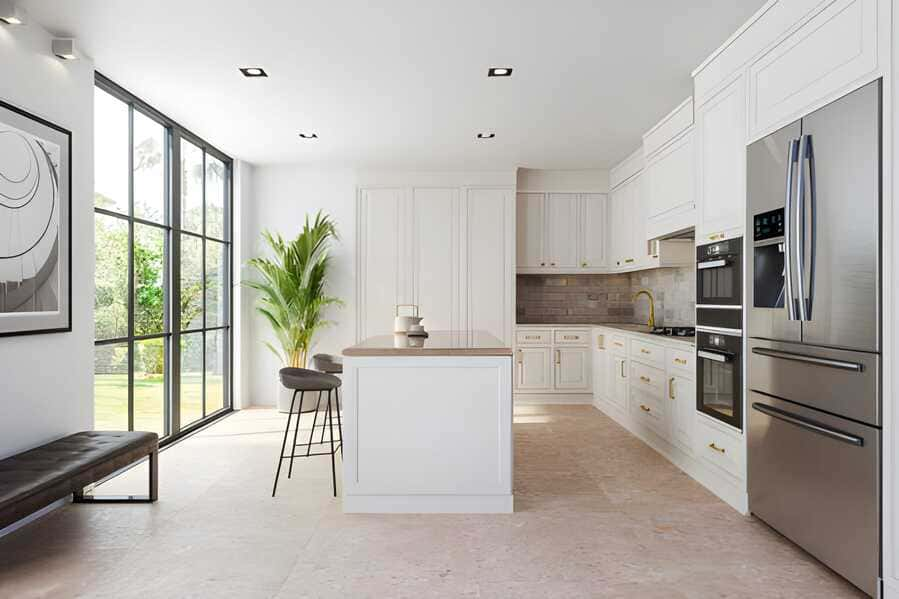
Open plan living works when the kitchen and dining zone feels calm, easy to clean, and ready for guests. Use this plan to avoid layout regrets and budget shocks.
State the goal in one sentence. For example, “Cook five nights a week and host eight monthly.” Keep it in sight for every choice.
Mark walls, doors, windows, nibs, and pillars. Note services, floor wastes, and ceiling height. Check the path to the front door for large deliveries. A quick scale sketch prevents guesswork.
Find water, gas, and power. Moving them is possible but affects time and cost. Decide changes on paper before you order. Confirm vent locations and any roof access for ducting.
Aim for 1000 to 1100 mm between bench and island. Keep 900 mm for main walkways. Allow 300 mm stool overhang. Prioritise flow over seat count.
Draw a one metre lane behind every chair. If you cannot keep that, reduce stools or shorten the island. Make sure fridge doors open without blocking walkways. Leave a clear landing space next to the oven and microwave for hot trays.
Laminate is budget friendly and has improved. Engineered stone is low care and consistent. Solid timber is warm but needs oiling. Porcelain or ceramic splashbacks are tough and easy to wipe. Matt finishes hide fingerprints better than high gloss.
Porcelain handles spills and heat. Large formats calm the eye and reduce grout. If the kitchen flows to a family room or an alfresco, plan a continuous look. Dry lay one full module of French pattern tile first to confirm border widths and avoid thin cuts at walls.
Australian sun is strong. Very dark floors get hot. Very light floors can glare. Mid tones like soft grey, oatmeal, or pale taupe are a safe pick. Test samples at 2 pm in bare feet. The feel underfoot is as important as the look.
Choose mid tone grout near cook zones. Very light grout shows sauce. Very dark grout can fade in bright sun. Use metal trims on exposed edges. Clean with a pH neutral solution. Seal natural stone on schedule and keep spare tiles for future repairs.
Hydronic and electric systems both work under tile. Confirm the tile and adhesive are rated for heat. Place sensor probes where they read floor temperature, not over heating cables. Bring the system up to temperature slowly after install so adhesives cure correctly. Program a lower overnight set point to avoid big morning swings.
Use task light over benches. Add warm ambient light for dining. Include simple accents for shelves or splashbacks. Fit dimmers so the room can shift from cooking to dinner. Avoid a single centre oyster that leaves corners dull.
Keep task lights directly above benches, not behind your head. Space downlights about 900 to 1200 mm apart depending on output. Hang pendants so the lowest point sits roughly 700 to 750 mm above the island. Use warm white for dining and neutral white for prep runs.
Match rangehood width to the cooktop. Duct outside if you can. Re-circulating is a last resort. Check the decibel rating so you can talk while it runs. In tight homes, a window that opens helps make-up air.
Add GPOs for benchtop appliances and an island outlet for mixers. A charging drawer keeps phones and tablets off the main prep run. Plan a hidden spot for the toaster and kettle so cords do not clutter the bench.
Add a rug under the table and curtains to soften sound. Felt pads under chairs stop scraping. Open shelves with crockery also reduce echo.
List every line. Cabinets, benchtops, splashback, floor, paint, lights, plumber, electrician, tiler, appliances, delivery, and waste removal. Add 10 percent for surprises. If the total hurts, change scope before you order. Do fewer things well rather than many things thin.
Ask how each trade measures, quotes, and books time. Seek reviews that mention clean sites and on time handover. Get start and finish windows in writing. Confirm who protects floors and controls dust.
Cabinet carcasses can take weeks. Benchtops depend on the fabricator schedule. Popular tiles and lights also move in cycles. Order early and store on site only when the room is ready and dry.
Do services and rough in. Close walls and apply the first coat of paint. Lay the floor if it runs under cabinets. Fit cabinets. Template and install benchtops. Tile the splashback. Fit lights and power plates. Seal edges. Do the final paint. Bring stools and a rug in last.
Wrap benchtops as soon as they are set. Use drop sheets and sticky mats at entries. Keep cardboard offcuts for pathways so tools do not mark floors. Ask trades to lift, not drag, appliances. Store doors and panels upright with soft spacers.
What tile sizes work best in a kitchen and dining room
Large formats calm busy rooms and reduce grout. Near doors to a deck, choose a surface with suitable grip. Keep joints consistent for a tidy look.
How do I place the island if my room is narrow
Reduce stool count and keep 1000 to 1100 mm between island and bench. A shorter island that preserves flow beats a long island that blocks paths.
Is timber flooring a bad idea near the cooktop
It can work if you accept upkeep. Use a mat near the sink and reseal on the brand schedule. Tiles are easier if you cook often.
Do pendants over the island still make sense
Yes, at the right height. Use two or three small pendants rather than one large one. Add downlights for task work so you can dim the pendants at dinner.
How do I limit echo
Soft furnishings help. A rug, curtains, and felt pads reduce noise. Shelves with plates also soften sound. Keep hard surfaces balanced with soft ones.
What grout colour is practical
Mid tone hides most marks. Match the tile background for a calm read. Use contrast only if you want the joints to stand out.
Can I DIY the floor
Small spaces are possible if you have the tools and time. Large areas, steps, or drainage fixes are best done by a pro. Bad prep is expensive to repair.
A kitchen and dining upgrade should feel simple in daily life. Start with a clear brief and honest measurements. Plan safe walkways and simple zones. Choose surfaces that cope with heat, spills, and a weeknight rush. Layer light, vent properly, and budget with real numbers. Follow a clean install order and protect finishes as you go. If you work to this plan, the space will stay calm and useful long after the paint dries.

Welcome to Tile Pro Depot! We established this site to service the specific needs of the tile installation professional. Tile installation tools, tile setting materials, premixed grout and more tile installation products online at Tile Pro Depot.